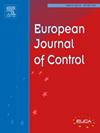新型三维混沌系统的分析、隐藏共存、自适应控制、偏置升压控制及电路实现
IF 2.6
3区 计算机科学
Q2 AUTOMATION & CONTROL SYSTEMS
引用次数: 0
摘要
本研究提出了一个包含三个不稳定点的新型三维系统的构建。该系统具有三个关键属性。该系统被识别为具有两个非线性元素的混沌行为。随后通过自适应控制器的设计解决了与控制相关的问题。自适应控制方法考虑了潜在参数的不确定性。考虑到只有一个状态变量可以用于反馈控制器的开发,可以得出结论,由于所采用的方法,一个参数仍然完全未指定。自适应控制器采用了李雅普诺夫稳定性分析的原理。该系统还显示在指定参数范围内包含多个隐藏共存状态。在以不稳定平衡点为特征的混沌系统中,尚未监测到新特征的综合影响。利用MultiSIM开发了新型混沌系统的电子模拟电路,从而证明了电路实现的数学模型的实际可行性。本文章由计算机程序翻译,如有差异,请以英文原文为准。
Analysis of novel 3D chaotic system, hidden coexisting, adaptive control, offset boosting control, and circuit implementation
This study presents the construction of a novel three-dimensional system that includes three unstable points. The system exhibits three key properties. This system is identified as demonstrating chaotic behavior characterized by two nonlinear elements. Control-related issues are subsequently addressed through the design of the adaptive controller. The adaptive control method incorporates considerations for potential parameter uncertainty. Given that only a single state variable is accessible for the development of the feedback controller, it is concluded that one parameter remains entirely unspecified as a result of the employed methodology. The adaptive controller employs principles derived from Lyapunov stability analysis. The system was also shown to contain multiple hidden coexisting states within a specified parameter range. The combined influence of novel features has not yet been monitored in a chaotic system characterized by unstable equilibrium points. An electronic analogue circuit of the novel chaotic system was developed using MultiSIM, thereby demonstrating the practical viability of the mathematical model for circuit implementation.
求助全文
通过发布文献求助,成功后即可免费获取论文全文。
去求助
来源期刊

European Journal of Control
工程技术-自动化与控制系统
CiteScore
5.80
自引率
5.90%
发文量
131
审稿时长
1 months
期刊介绍:
The European Control Association (EUCA) has among its objectives to promote the development of the discipline. Apart from the European Control Conferences, the European Journal of Control is the Association''s main channel for the dissemination of important contributions in the field.
The aim of the Journal is to publish high quality papers on the theory and practice of control and systems engineering.
The scope of the Journal will be wide and cover all aspects of the discipline including methodologies, techniques and applications.
Research in control and systems engineering is necessary to develop new concepts and tools which enhance our understanding and improve our ability to design and implement high performance control systems. Submitted papers should stress the practical motivations and relevance of their results.
The design and implementation of a successful control system requires the use of a range of techniques:
Modelling
Robustness Analysis
Identification
Optimization
Control Law Design
Numerical analysis
Fault Detection, and so on.
 求助内容:
求助内容: 应助结果提醒方式:
应助结果提醒方式:


